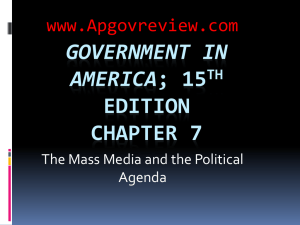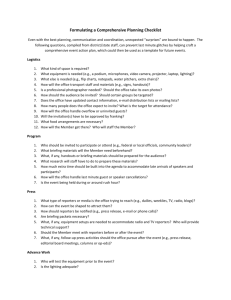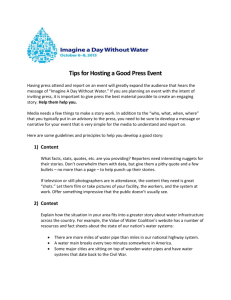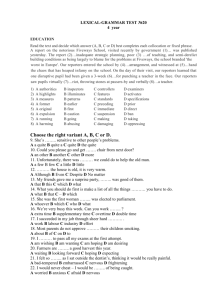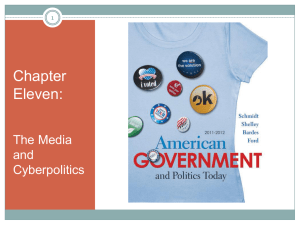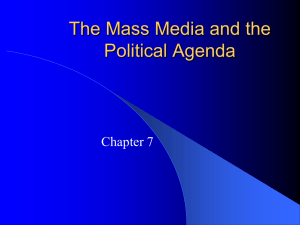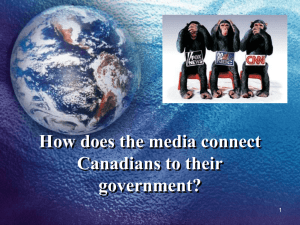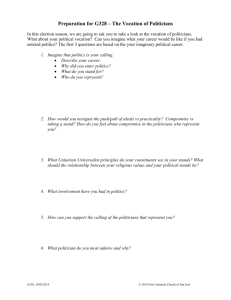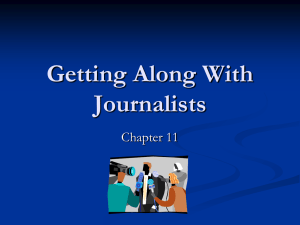Chapter 7
advertisement
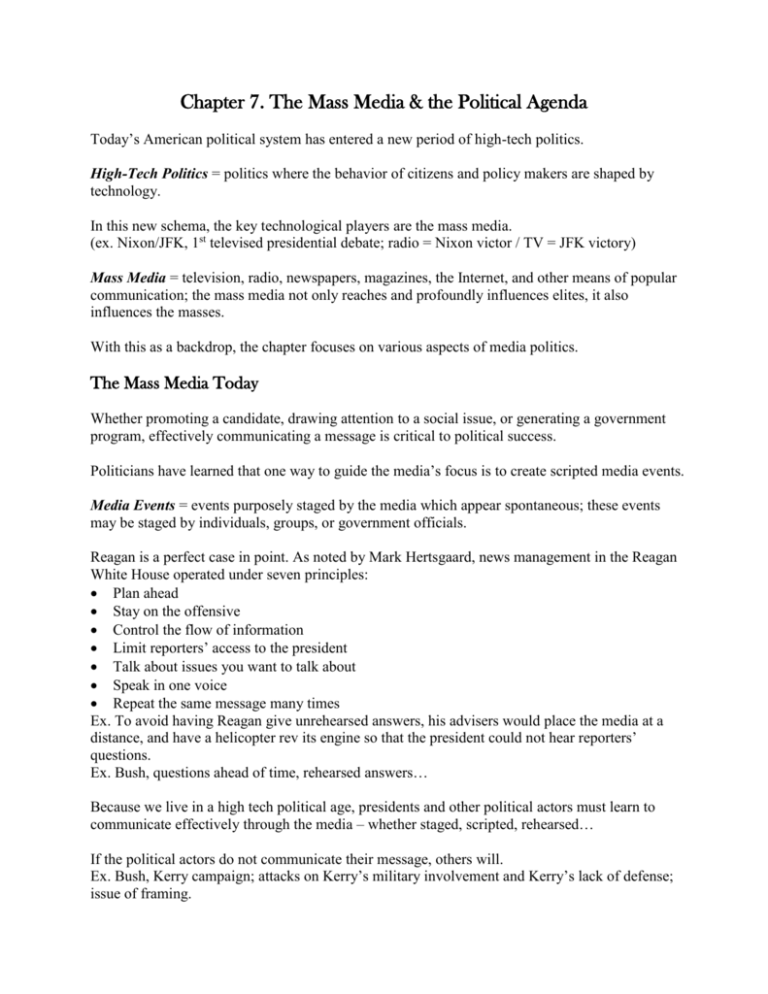
Chapter 7. The Mass Media & the Political Agenda Today’s American political system has entered a new period of high-tech politics. High-Tech Politics = politics where the behavior of citizens and policy makers are shaped by technology. In this new schema, the key technological players are the mass media. (ex. Nixon/JFK, 1st televised presidential debate; radio = Nixon victor / TV = JFK victory) Mass Media = television, radio, newspapers, magazines, the Internet, and other means of popular communication; the mass media not only reaches and profoundly influences elites, it also influences the masses. With this as a backdrop, the chapter focuses on various aspects of media politics. The Mass Media Today Whether promoting a candidate, drawing attention to a social issue, or generating a government program, effectively communicating a message is critical to political success. Politicians have learned that one way to guide the media’s focus is to create scripted media events. Media Events = events purposely staged by the media which appear spontaneous; these events may be staged by individuals, groups, or government officials. Reagan is a perfect case in point. As noted by Mark Hertsgaard, news management in the Reagan White House operated under seven principles: Plan ahead Stay on the offensive Control the flow of information Limit reporters’ access to the president Talk about issues you want to talk about Speak in one voice Repeat the same message many times Ex. To avoid having Reagan give unrehearsed answers, his advisers would place the media at a distance, and have a helicopter rev its engine so that the president could not hear reporters’ questions. Ex. Bush, questions ahead of time, rehearsed answers… Because we live in a high tech political age, presidents and other political actors must learn to communicate effectively through the media – whether staged, scripted, rehearsed… If the political actors do not communicate their message, others will. Ex. Bush, Kerry campaign; attacks on Kerry’s military involvement and Kerry’s lack of defense; issue of framing. The Development of Media Politics When the Constitution was written, there was virtually no daily press. The daily newspaper emerged in the mid-19th century, and television and radio emerged in the 1st half of the 20th century. Ex. During the Hoover administration (1929-33), reporters submitted their questions to the president in writing, and he – if he chose to – responded in writing. As noted by Hoover, “The President of the US will not stand and be questioned like a chicken thief by men he does not even know.” Imagine if George W. Bush made such a statement today. What would be some of the repercussions? However, Hoover’s successor did not feel the same. In fact, Franklin D. Roosevelt (1933-45) practically invented media politics. To FDR, the media was a potential ally. He even promised reporters two press conferences a week; this resulted in over 1000 press conferences during his 12 years in the White House. Press Conference = meeting of public officials with reporters. FDR was also the first president to use the radio to broadcast his “fireside chats” to the Depression-ridden nation. When FRD learned that Thomas E. Dewey had purchased 15 minutes of airtime on NBC immediately following his address, he cut his talks down to 14 minutes. Because he chose to remain silent during the last minute of his time, many Americans thought the network had experienced technically difficulty and changed their dials before Dewey came on. The fact that he was confined to a wheelchair and Americans were unaware, illustrates the respect he received from the media. In fact, unlike today (where the president’s health is public business), the idea that a political leaders health status might be public business was alien to reporters. Ultimately, Roosevelt’s crafty use of the media helped him win four presidential elections. (Amendment 22, Presidential Term Limits, 1951) This cozy relationship between politicians and the media lasted through the 1960s. As noted by ABC’s Sam Donaldson, “many reporters saw themselves as an extension of the government, accepting with very little skepticism what government officials had told them.” In addition, coverage of a politicians personal life was generally off limits. Ex. RW Apple, New York Times, saw a beautiful young woman being escorted to JFK’s suite. When he took the story to his editor, he was told “your suppose to report on political and diplomatic policies, not girlfriends.” Do you agree with the reporter? Should we focus on political issues and not personal issues? Would this produce more policy-focused political campaigns? Consider the case of Bill Clinton and Monica Lewinsky. The cozy relationship between the media and politicians came to end with the Vietnam War and the Watergate scandal. Today’s newspapers work in an environment of cynicism. To them, politicians rarely tell the truth; therefore, it is up to them to dig out the truth (aka investigative reporting) Investigative Reporting = the use of in-depth reporting to unearth scandals, scams, and schemes, which at times puts reporters in adversarial relationships with political leaders. Many political scientists have become critical of investigative reporting because it pits reporters against political leaders, and it fosters greater public cynicism and negativity towards politics. Therefore, whether or not mass media coverage is ultimately in the public’s best interest is much debated. When scholars examine the mass media, they distinguish two kinds: print media and broadcast media. Print Media = newspapers and magazines Broadcast Media = television and radio However, there is a third new avenue of political communication – narrowcasting Narrowcasting = media programming on cable TV or the Internet that is focused on one topic and aimed at a particular audience (ex. MTV = music, ESPN = sports, C-SPAN = politics) Private Control of the Media: one of the main reasons America has such a rich diversity of media sources is that journalism has long been big business in the US, with control of virtually all media outlets being in private hands. The major media in America = Big Business Ultra Concentrated Media (chart) The Six Largest Media Corporations in the World (notes) With corporate business managers increasingly calling the shots, American journalism has definitely been affected. As illustrated in the following section, striving for profits greatly shapes how the news is reported in America. Reporting the News Millions of new and different events happen every day; journalist must decide which are newsworthy and which are not. Ex. Although state dinners take place all the time, they are rarely reported… unless something interesting takes place … Bush Sr throwing up over the Japanese Prime Minister in 1992. Ex. Political candidates talk to supporters all the time when campaigning, but only “newsworthy” events are reported … Howard Dean screaming to a crowd of supporters after the 2004 Iowa caucus (clip repeated 600 times in 4 days, thus obscuring any serious discussion of the issues) What this shows is that in their search for the unusual, the news media gives its audience a peculiar view of events and policymakers. This also illustrates that news reporting has become a business in America. The quest for profits shape how journalists define what is newsworthy, where they get their information, and how they present it. Because some types of news stories attract more viewers or readers than others, certain biases are inherent in what the American public sees and reads. Thus the reason you are doing media journals – to really understand how the media presents news and how news is oftentimes bias. Finding the News: most major news organizations assign their best reporters to particular beats. Beats = specific locations from which news often emanates – Congress, White House. Because policymakers depend on the media to spread certain information, they oftentimes feed stories to reporters in the form of trail balloons. Trial Balloons = information leaked to see what the political reaction will be. Ex. Before President Clinton admitted to having an inappropriate relationship with Lewinsky, top aids leaked the story to the New York Times. Because the public reacted that it was time he admitted the relationship, it was easier for Clinton to come clean. Presenting the News: once the news has been “found,” it is neatly compressed into a 30 second news segment or a small article. As a result of limited time and space, the stories that are reported tend to be superficial. In addition, complex and difficult issues such as Medicare reform, tax cuts, and the deregulation of the communications industry tend to be ignored by the media. Strangely enough, even though technology has enabled us to pass along information at a greater speed, news coverage has become less thorough. Ex. Although newspapers used to print the entire text of important speeches, only the New York Times continues to do this – and even they have cut back sharply. In place of speeches, Americans now hear sound bites. Sound Bites = short video clips of approximately 15 seconds See Figure 7.2, The Incredible Shrinking Sound Bite (Book, p. 226) Rather than presenting their audience with the chicken, the media typically gives us the McNugget. Consequently, politicians have found it difficult to get their messages covered by the major networks because the networks are focused on viewer ratings. Bias in the News: many people believe that the media is biased in favor of one point of view. Although many claim that the media is liberal, studies have shown that the media is not systematically biased toward a particular ideology or party. Most stories are presented in a point/counterpoint format in which two opposing points of views are presented, and the audience is left to draw its own conclusions. Two factors explain the neutrality in the media – journalists believe in objectivity because it is rewarded by their editors; and, media outlets have a direct financial stake in attracting viewers and subscribers so they do not want to lose their audience by appearing biased. In fact, competition producers uniformity in reporting. Based on the work you have been doing with your media journals, would you argue that the media is unbiased? As noted by the authors, just because the news lacks partisan bias, does not mean that they never distort reality in their coverage of events. Ideally, the news should mirror reality; in practice, there are far too many possible stories for this to be the case. Journalist must choose which stories to cover and to what degree. Consequently, the overriding bias is to cover stories that will draw large audiences. Ex. Talking Head vs. Infotainment Talking Head = a shot of a persons head talking directly to the camera; because this is visually unappealing and viewed as boring, the major commercial networks rarely show a politician talking one-on-one for very long. Infotainment = the merging of hard news and entertainment in news presentations; produces short, snappy, and sensational news The News and Public Opinion Studying the effect of the news media on people’s opinions and behaviors is a difficult task. For instance, the effect of one story on public opinion may be trivial, whereas the effects of numerous stories may be important. However, numerous scholars have found a link between the mass media and public opinion: Baumgartner and Jones, mass media influences policy outcomes Iyengar and Kinder, mass media shapes and intensifies viewers’ sense of which national problems are important and which are not. Miller and Krosnick, the media does not manipulate the public; in fact, sophisticated citizens rely on the media as a credible institutional source of information Overall, by increasing public attention to specific problems, the media influences how the public evaluates political leaders. This is done through framing = how an issue is presented. Ex. When unemployment goes up but inflation goes down, does support for the president increase or decrease? This depends on which story the media emphasizes. In 1992, the media focused on slow economic growth rather than low inflation rates; consequently, this hindered Bush Sr’s reelection campaign. In 2000, the media focused on Gore’s character, as opposed to the excellent economic performance under the Clinton-Gore administration; thus hindering Gore’s presidential campaign. The media also has a dramatic effect on how the public evaluates specific events by emphasizing one particular news aspect over others. Ex. The press gave substantial coverage to the President when he stated that there were WMD in Iraq. Consequently, many Americans supported the war in Iraq. However, regardless of the fact that Bush later claimed that he never said there were WMD, because of the media coverage, many Americans continue to believe that there are WMD in Iraq. Ex. The medias’ focus on Al Gore’s misstatements during his first presidential debate in 2000 (ex, he invented the Internet) led to dramatic decreases in public support. Although much remains unknown about the effects of the media and the news on American political behavior, enough is known to conclude that the media is a key political institution. The media controls much of the technology; consequently, they control much of what Americans believe about politics and government. Therefore, it is important to examine the American political agenda and the media’s role in shaping it. The Media’s Agenda Setting Function John Kingdon defines the policy agenda as “the list of subjects or problems to which government officials, and people outside of government closely associated with those officials, are paying some serious attention at an given time.” Political activists depend heavily on the media to get their ideas placed on the government agenda. Policy activists are often called policy entrepreneurs. Policy Entrepreneurs = people who invest their political capital in an issue; policy entrepreneurs can either be in or out of government, elected or appointed officials, or interest groups or research institutions. (Ex. EEO policy, Linda Chavez, Center for Equal Opportunity, Sun Times editorials, advocates color blind policy) Their arsenal of weapons include: press releases, press conferences, letter writing, and even interest group formation. However, the media is not always monopolized by elites; the poor also have access. Ex. Civil Rights groups in the 1960s relied heavily on the media to tell their stories of unjust treatment. Understanding the Mass Media The mass media acts as a key linkage institution between the people and policymakers, and has a profound impact on the political policy agenda. The media’s watchdog function helps to restrict politicians. In other words, every new government proposal is met with skepticism because reporters view their job as a crusade against foul play and unfairness in government and society. Ex. This is evident with the attacks on government by reporters after Hurricane Katrina. Information is the fuel of democracy, yet media coverage tends to be superficial. Because of economic pressures, the media is biased towards dramatic stories that attract people’s interests rather than extended analysis of complex issues.
